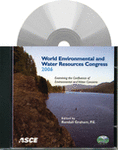Converging RCC Stepped Spillways
Publication: World Environmental and Water Resource Congress 2006: Examining the Confluence of Environmental and Water Concerns
Abstract
The United States Department of Agriculture (USDA), Natural Resources Conservation Service (NRCS) estimates that nearly half of the small watershed dams constructed with their assistance will reach the end of their planned service life within the next 10 years. While many of these structures were originally built in rural environments, urban communities have encroached upon these structures over the years, making it difficult to address issues such as the maintenance of adequate spillway capacity to meet current dam safety standards. The urban infrastructure surrounding these structures limits the options available for dam rehabilitation. For instance, raising the dam or widening the existing auxiliary spillway to increase spillway capacity is often not a viable option due to land right constraints or changes in topography. Therefore, one of the more popular choices for increasing spillway capacity is the use of roller compacted concrete (RCC) stepped spillways. Two advantages of RCC stepped spillways are that they can be placed over the top of the dam and that they can provide considerable energy dissipation within the spillway chute. When placing an RCC spillway over an existing embankment dam, it is often desirable for the width of hydraulic control section to be greater than the width available to outlet the flow into the downstream channel. A generalized study utilizing a three-dimensional, 1:22 scale physical model was conducted to evaluate the influence converging training walls have on the flow characteristics on a stepped spillway. Vertical walls having convergence angles ranging from 0 degrees to 70 degrees were tested in conjunction with a spillway having a chute slope of 3(H):1(V) and a prototype step height of 0.3 m (1 ft). Water surface profiles in the central area of the chute and along the walls were collected and analyzed for each spillway configuration. Results of the study are presented in a format that will assist engineers in determining the required wall height for this type of a converging chute spillway.
Get full access to this chapter
View all available purchase options and get full access to this chapter.
Information & Authors
Information
Published In
Copyright
© 2006 American Society of Civil Engineers.
History
Published online: Apr 26, 2012
ASCE Technical Topics:
- Channels (waterway)
- Dams
- Design (by type)
- Drop structures
- Embankment dams
- Engineering fundamentals
- Flow profiles
- Fluid dynamics
- Fluid mechanics
- Geotechnical engineering
- Hydraulic engineering
- Hydraulic structures
- Hydrologic engineering
- Spillways
- Stream channels
- Structural design
- Structural engineering
- Structural members
- Structural safety
- Structural systems
- Structures (by type)
- Walls
- Water and water resources
- Waterways
Authors
Metrics & Citations
Metrics
Citations
Download citation
If you have the appropriate software installed, you can download article citation data to the citation manager of your choice. Simply select your manager software from the list below and click Download.
